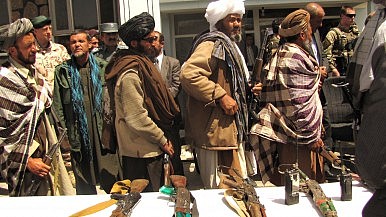By Ahmad Shuja Jamal
 The Taliban’s announcement of a unilateral ceasefire is perhaps the most significant recent development in Afghanistan’s long-foundering peace efforts. Given the myriad spoilers and the potential of breakdown of discipline in the ranks, the significance of the ceasefire is not in whether it will hold; instead, it is in the politics of the move. The Taliban have long either declined to participate in peace talks or denied involvement in talks with the Afghan government when reports emerged. They deemed the Afghan government as not serious about peace and did not want their foot soldiers to see their leaders engaging with a government that they are fighting against.
The Taliban’s announcement of a unilateral ceasefire is perhaps the most significant recent development in Afghanistan’s long-foundering peace efforts. Given the myriad spoilers and the potential of breakdown of discipline in the ranks, the significance of the ceasefire is not in whether it will hold; instead, it is in the politics of the move. The Taliban have long either declined to participate in peace talks or denied involvement in talks with the Afghan government when reports emerged. They deemed the Afghan government as not serious about peace and did not want their foot soldiers to see their leaders engaging with a government that they are fighting against.
This is precisely why it is significant that the Taliban chose to have their ceasefire overlap with that of the Afghan government. The act represents a cautious dip of the toe in public cooperation toward peace, a way for the Taliban to test the waters of publicly working with the Afghan government.
They maintained a studious silence on President Ashraf Ghani’s peace offer in February, curious behavior from a group that is often quick to dismiss such overtures. By choosing to follow the Afghan government’s unilateral ceasefire, they are now communicating a public response.
Much could go wrong, and the Taliban know it.
For one, there are the obvious questions of whether the two sides will follow through on the announcement come Eid. In some places, the Taliban foot soldiers are eyeball-to-eyeball with Afghan security forces or the untrained Afghan militia set up to defend their localities. Any trigger — from old roadside bombs to nervous soldiers — could start skirmishes. The likelihood of fighting is magnified further by the difficulty in separating the Taliban from other insurgent groups or criminal elements.
This is why the significance of the dual ceasefires is more in whether the politics work out than the ceasefires themselves.
But the Taliban know from experience that plenty could go wrong with the politics, too. That is why they have carefully wrapped the gesture in heavy religious and cultural symbolism. To protect themselves if the gambit goes awry, the insurgent group is messaging the ceasefire as an effort to allow Afghans to observe the Eid-ul-Fitr festival in peace.
This insurance policy is also significant because it indicates a set of ideals based on which cooperation could evolve between the Taliban and the Afghan government. In their ceasefire announcement, the Taliban said they want to give “our compatriots” the peace to perform the “prayers and other rituals” during the Eid festival. The Taliban frequently appeal to religion, culture, and patriotism in their propaganda.
This is a sign that the involvement of important Muslim-majority countries such as Indonesia and Saudi Arabia in peace efforts could be helpful. They could not only act as arbiters and trusted third-parties, but also use their clout with regional actors such as Pakistan to enable a broader regional climate in which peace could grow.
The political climate inside Afghanistan has become more conducive toward peace than ever. Today, few major Afghan political leaders or parties openly oppose peace with the Taliban, a massive shift from blanket opposition a few years ago by the political mainstream.
Furthermore, a grassroots peace movement emerging from Taliban-held areas is challenging the insurgents to walk their talk of protecting Afghan lives. The Taliban can only dismiss the movement’s calls for so long while preserving their claim to want peace for the Afghan people.
The Helmand Peace March, as the movement has come to be known, has proved more durable than people had expected, its members demonstrating a solid commitment to peace by marching hundreds of kilometers to Kabul in the searing heat while observing the Ramadan fast. The movement could grow to be a catalyst toward peace because it could give the Taliban and the government a justification from the grassroots to engage in more confidence building measures.
Neither the Afghan government nor the Taliban laid out any conditions for their ceasefires. If this is possible for three days, it can certainly be possible for longer, too. That’s a good place to build on this opening.
If backed up by enabling diplomacy from the international community and patient engagement between Taliban and the government, these dual ceasefires could turn into a fully fledged peace process.
Ahmad Shuja Jamal is the editor in chief of the Georgetown Public Policy Review and a Fulbright scholar at Georgetown University McCourt School of Public Policy. He researches and writes about international security and human rights.
No comments:
Post a Comment